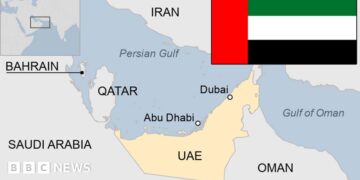Decoding the Influence of Carbonyl Compounds on Ozone Formation in Shantou’s Coastal Atmosphere
As air pollution continues to threaten both environmental integrity and human health worldwide, understanding the chemical interactions that drive pollutant formation is more critical than ever. A recent investigation centered on Shantou, a rapidly urbanizing coastal city in eastern China, reveals the significant role carbonyl compounds play in generating photochemical ozone—a harmful pollutant linked to respiratory ailments and ecological damage. This research offers fresh perspectives on how these organic chemicals contribute to ground-level ozone accumulation amid Shantou’s unique blend of industrial growth and maritime influences.
Carbonyl Compounds: Key Drivers Behind Ozone Generation in Urban Coastal Settings
In Shantou’s atmosphere, carbonyl compounds—mainly aldehydes and ketones—are increasingly recognized as vital precursors for photochemical ozone production. When exposed to sunlight, these molecules undergo complex reactions with other atmospheric constituents such as volatile organic compounds (VOCs), leading to elevated ozone concentrations near the surface layer of the troposphere. This process is especially pronounced in urban environments where intense solar radiation combines with high emissions from vehicles and industries.
The following factors underscore how carbonyls influence ozone dynamics:
- Emission Sources: Predominantly originating from automobile exhausts, manufacturing plants, and natural biogenic emissions like plant metabolism.
- Photolytic Mechanisms: Sunlight breaks down carbonyl molecules into reactive radicals that catalyze further chemical reactions culminating in ozone formation.
- Meteorological Conditions: Variations in temperature and humidity modulate both the lifespan and reactivity of these compounds within Shantou’s atmosphere.
| Carbonyl Compound | Tendency for Ozone Formation | Main Emission Source |
|---|---|---|
| Aldehydes (e.g., Formaldehyde) | Very High | Vehicle Exhausts |
| Ketones (e.g., Acetone) | Moderate | Chemical Manufacturing Processes |
| Acetaldehyde (Biogenic Origin) | Sizable Contribution | Naturally Emitted by Vegetation |
The Unique Impact of Coastal Geography on Photochemical Reactions in Shantou
The coastal environment surrounding Shantou introduces additional complexity into atmospheric chemistry by blending marine aerosols with terrestrial pollutants. Sea breezes transport salt particles and organic matter inland, which interact with urban emissions creating a highly reactive chemical milieu conducive to secondary pollutant generation such as ground-level ozone.
This interplay is influenced by several environmental parameters:
- Aerodynamic Transport Patterns: Local wind regimes redistribute pollutants across land-sea interfaces affecting concentration hotspots.
- Aerosol Loadings: Particulate matter can scatter or absorb sunlight altering photolysis rates essential for radical formation.
- Biospheric Contributions:Vegetation emits VOCs that react synergistically with anthropogenic carbonyls enhancing overall reactivity.
- < strong >Humidity Levels :Elevated moisture accelerates breakdown pathways for certain carbonyl species .
- < strong >Temperature Fluctuations :Warmer conditions boost reaction kinetics , intensifying photochemical activity .
- < strong >Solar Intensity :Sunlight availability directly drives radical generation necessary for initiating oxidation chains .
< th >Environmental Factor< / th >< th >Effect on Ozone Production< / th >
< /thead >< td >Humidity< / td >< td >Promotes faster degradation of carbonyl precursors via photolysis.< / td > < td >Temperature< / td >< td >Enhances speed of chemical reactions forming radicals.< / td > < td >Solar Radiation< / td >< td >Supplies energy needed for radical initiation driving ozone synthesis.< / td > Tackling Ozone Pollution: Approaches Focused on Carbonyl Compound Reduction in Urban Areas Like Shantou and Beyond
Urban centers such asShanto face mounting challenges balancing economic expansionwithenvironmental protection.Measures aimed at curbingcarbonylemissionscanplayapivotalroleinmitigatingphotochemicallygeneratedozonepollution.
Effective interventions include:- Tightening Regulations: Enforcing stricter emission standards targeting vehicle exhaust systemsandindustrial discharges reduces primary sourcesofcarbonylesignificantly.
- Pioneering Technology Deployment: Adopting advanced pollution control devices like catalytic converters, photocatalytic oxidation units, and biofiltration systems helps minimize releaseofcarbonylemissionat their origin.
- Cultivating Public Awareness: Educational campaigns highlightingthehealthrisksassociatedwithozoneexposureandtheimportanceofreducingprecursoremissionsencouragecommunityparticipation. & nbsp;Real-time air quality monitoring platforms &&&&&amp;amp;amp;amp;amp;amp;amp;; public reporting tools empower residents tomake informeddecisionsaboutoutdooractivitiesduringhigh-pollutionperiods.& nbsp;& nbsp;
</ul><h2>Final Thoughts</h2>
<p>
The exploration into howcarbonylcompoundsdrivephotochemicalozoneformationinShantuunderscoresanurgentneedforintegratedairqualitymanagementstrategies.Inthiscoastalcitywhereindustrializationmeetsmaritimeclimate,thecomplexchemicalinteractionsdemandtailoredapproachesthataddressbothanthropogenicsourcesandnaturalprocesses.Byilluminatingtheseintricatepathways,researchersprovidevaluableguidanceforpolicymakersandenvironmentaladvocatesworkingtoimprovepublichealthoutcomes.Asaresult,thefindingscallforcollaborativeeffortsamongscientistsgovernments,andlocalcommunitiestodevelopinnovativesolutionsaimedatsustainingcleanerairinthefaceofurbanexpansionandclimatechangechallenges.NotonlydoesthisresearchbenefitShanto,butitalsoservesasamodelforothercoastalmetropolisesgrapplingwithsimilarairqualityissuesglobally.
</p></article>
. . .















